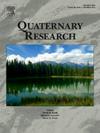从家庭壁炉中记录的地球磁场所揭示的Huastecs(墨西哥湾)的早期发展
IF 1.8
3区 地球科学
Q3 GEOGRAPHY, PHYSICAL
引用次数: 0
摘要
摘要对墨西哥塔毛利帕斯州Chak Pet考古居民点最近发现的家庭壁炉和燃烧过的地板进行了详细的磁矿物学和考古地磁研究。这项研究的目的是获得可靠的绝对时间限制,在形成时期的早期发展的卫星。定向手样本对应于四个家庭壁炉和一个燃烧过的地板。连续热磁曲线显示了大部分不可逆行为,而钛磁铁矿、钛磁铁矿和针铁矿被认为携带剩余磁化。总共有87个样品使用交变场程序进行自然剩余磁化的逐步退磁。得到了两个炉台和一个燃烧地板的29个样品的特征剩磁方向。没有获得单一的、技术上可接受的古强度测定。Chak Pet的新考古地磁年龄间隔允许将这个定居点的起源定位在墨西哥湾,在中期形成时期(公元前900-600年)一直持续到后期形成时期(公元前350-100年)。新的考古磁年龄与陶器诊断分析一致。年代考古元素与陶瓷类型和不同的墓葬相关联,为校准它们的年代和地层位置提供了可靠的工具。本文章由计算机程序翻译,如有差异,请以英文原文为准。
On the early development of Huastecs (Gulf of Mexico) revealed by the Earth's magnetic field recorded in domestic hearths
Abstract A detailed magnetic mineralogy and archaeomagnetic study was carried out on recently discovered domestic hearths and burned floors at the Chak Pet archaeological settlement (Tamaulipas, Mexico). The study aimed to obtain reliable absolute chronological constraints on the early development of Huastecs during the Formative period. Oriented hand samples corresponded to four domestic hearths and one burned floor. Continuous thermomagnetic curves revealed mostly irreversible behavior, while titanomagnetites, titanomaghemites, and goethites are assumed to carry the remanent magnetization. In total, 87 specimens were subjected to stepwise demagnetization of natural remanent magnetization using an alternating field procedure. Characteristic remanent magnetization directions were obtained for 29 samples of two hearths and one burned floor. No single, technically acceptable paleointensity determination was obtained. The new archaeomagnetic age intervals for Chak Pet allow locating the origin of this settlement at the Gulf of Mexico within the Middle Formative (900–600 BCE) continuing until the Late Formative period (350–100 BCE). New archaeomagnetic ages are in accordance with the diagnostic pottery analysis. Dated archaeological elements are associated with both ceramic types and different sets of burials, providing a reliable tool to calibrate their chronological and stratigraphic positions.
求助全文
通过发布文献求助,成功后即可免费获取论文全文。
去求助
来源期刊

Quaternary Research
地学-地球科学综合
CiteScore
4.70
自引率
8.70%
发文量
57
审稿时长
3 months
期刊介绍:
Quaternary Research is an international journal devoted to the advancement of the interdisciplinary understanding of the Quaternary Period. We aim to publish articles of broad interest with relevance to more than one discipline, and that constitute a significant new contribution to Quaternary science. The journal’s scope is global, building on its nearly 50-year history in advancing the understanding of earth and human history through interdisciplinary study of the last 2.6 million years.
 求助内容:
求助内容: 应助结果提醒方式:
应助结果提醒方式:


